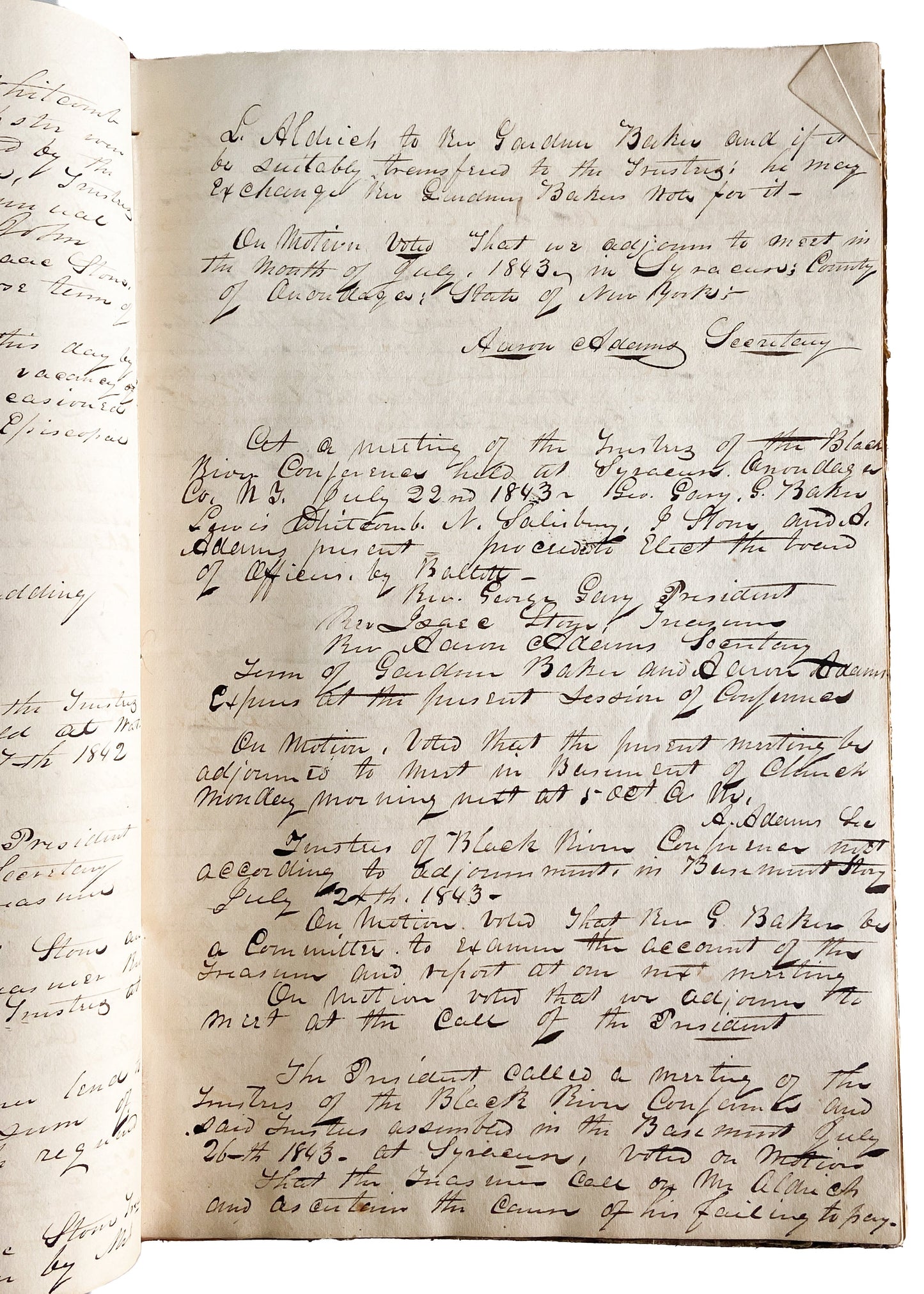Specs Fine Books
1841-1872 METHODIST BLACK RIVER CONFERENCE. Original Extensive Records, Documents, etc.
1841-1872 METHODIST BLACK RIVER CONFERENCE. Original Extensive Records, Documents, etc.
Couldn't load pickup availability
A wonderful piece of Methodist history, including two large corresponding mid-19th century ledgers recording the records of one of the most important Conferences and churches in the Methodist Episcopal Church of the 19th century.
The first manuscript volume contains a laid title to the first volume reads simply: Records of the Trustees of the Funds of the Black River Annual Conference 1841-1872."
The Black River Conference was formed in 1836 in Watertown, New York with Bishop Beverly Waugh presiding. It was originally evangelized by Methodist itinerants around 1803 and was part of the Philadelphia and Genessee Conferences. See the Methodist Minutes for 1878 [pp.62-65] and The Black River and Northern New York Conference Memorial for more extensive historical background. The Conference did not become formally recognized until 1841, which is recorded in the first of present two volumes.
Volume 1 contains 50 pages of manuscript plus multiple loose sheets. Volume 2 another c.100 pages of manuscript, measuring 8 x 12.5 and 9 x 13 inches respectively.
Volume one begins with a "Copy of an Act to Incorporate the Trustees of the Black River Annual Conference. Passed April 17th, 1841. This original Constitution is 6pp in length. From there, there are manuscript accounts of the annual meetings, each autographed, often by multiple persons; autographs are in [ ]. For 1842 [signed Aaron Adams]; 1843 [signed Aaron Adams]; 1844 [Gardner Baker, Aaron Adams and Beverly Waugh Secretarially]; 1845 [Aaron Adams]; 1846 [Hiram Mattison]; 1847 [Hiram Mattison and Thomas A. Morris]; 1848 [Gardner Baker and Edmund S. Janes]; 1849 [Elijah Hedding]; 1850 [Beverly Waugh]; 1851 [Edmund S. Janes and Hiram Mattison]; 1852 [Hiram Mattison and T. A. Morris]; 1853 [Matthew Simpson]; 1854 [T. A. Morris; N. Shepard, and P. L Dunning]; 1855 [Beverly Waugh; E. S. Janes, Isaac Bingham]; 1856 [Isaac Bingham; Osmon C. Baker]; 1857 [Hiram Shepard]; 1858 [E. R. Ames; Isaac Bingham]; 1859 [J. B. Foote; Levi Scott]; 1860 [Matthew Simpson. J. B. Foote]; 1861 [Osmon C. Baker. J. B. Foote]; 1862 [Edward R. Ames]; 1863 [E. S. Janes; J. B. Foote]; 1864 [J. T. Alden; Osmon C. Baker]; 1865 [C. Kingsley, C. L. Dunning, J. B. Foote]; 1866 [E. R. Ames; Isaac Bingham; B. Alden]; 1867 [A. J. Phelps, E. S. Janes]; 1868 [Matthew Simpson; Isaac S. Bingham]; 1869 [D. W. Clark, Isaac Bingham]; 1870 [Isaac Bingham, E. R. Ames]; 1871 [Isaac Bingham, E. S. James]; 1872 [Gardner Baker and Isaac Bingham].
Then there appears a laid in "Charter of Northern New York Conference of the Methodist Episcopal Church. An Act Incorporating the Trustees of the Northern New York Conference of the Methodist Episcopal Church, Passed April 10th, 1873. This I believe is when the two conferences joined.
Then there are several loose, related items, including an 1856 meeting note; a certificate of nomination signed by Edmund S. Janes [1846]; a certificate of election signed by Edmund S. Janes and Gardner Baker [1848]; a certificate of nomination signed by Beverly Waugh, etc.
The second volume is directly related to the Watertown M.E. Church and contains the original Register Documents [in manuscript] of the Church and extensive church records from 1849 through the 1860's, including registers of marriages; lists of baptisms; extensive records of the classes, probationers, and those received under ministries of W. D. Chase, Gardner Baker, O. C. Cole, etc.,
Fascinatingly, we have some really interesting items of church discipline, including those dismissed for intemperance, those "permitted to withdraw," dismissed for not fulfilling duties, some under charges, and in the same margins we see the effects of the Civil War with the dramatic upticks in death during the early to mid 1860's, etc.
Excellent state of preservation with usual wear, but solid and complete. An irreplaceable extensive suite of primary resource documents regarding the inner workings of one of the most influential 19th century Methodist Conferences and the foundational church in the Conference.
Share




















